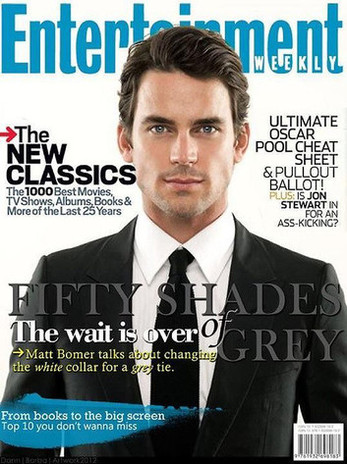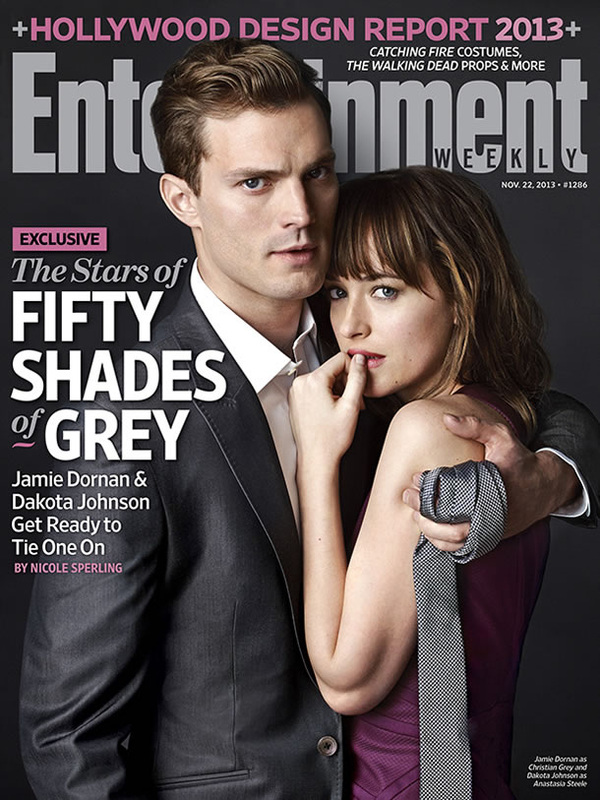Since the film version of Fifty Shades will be released on February 13, I am especially interested in revisiting two key fan works that came from the 2012 casting campaigns led by fans. By presenting themselves as “real,” authoritative texts, these paratexts blurred the distinction between canon (the official work) and fan works, since at the time of their creation there was no film – not even a screenplay.
A fan video purporting to be the “official trailer” to the unmade film was posted on YouTube in 2012. It was made by splicing old footage of various television and film projects of Matt Bomer and Alexis Bledel, the two actors cast by the fan creator as Christian and Ana. This fan-created “official trailer” worked in several ways as a teaser for fans: teasing that the Fifty Shades film would eventually be created and released, teasing the audience into believing the film was already forthcoming, and teasing that Bomer and Bledel had been decisively cast. But we can also think of this trailer as a fan response back to the media industries: showing producers and screenwriters what fans really wanted and expected from the filmic adaptation of the novel. After the trailer generated confusion, it was relabeled as “unofficial,” though its content continues to follow traditional commercial film trailer conventions through the use of ratings warnings, a logo for Universal Pictures, voiceover, and scenes edited out of sequence for dramatic effect.
In July 2014, the first official trailer for the commercial film, starring Jamie Dornan and Dakota Johnson, was released. The first few moments of this trailer are nearly identical to those in the fan video: Ana arriving at Christian’s office, harried, and nervously approaching him for their first meeting. There are other similarities in content between the two: shots of Bomer and Dornan’s nude chests, beds and bed sheets suggesting a sexual relationship, close-ups of various body parts. However, the tone of the two trailers is quite different. While the fan trailer emphasizes the BDSM subject matter of the novels, the commercial trailer only hints at this in its final few shots and instead has the affective quality of a romance. Nevertheless, for fans familiar with the much-circulated 2012 fan trailer, the similarities between the two are difficult to ignore.
Although they are not technically trailers, I would like to call attention to two other paratexts surrounding the Fifty Shades franchise. In 2012, during the casting speculation frenzy, a Photoshopped cover of the magazine Entertainment Weekly featuring Matt Bomer was disseminated online. The cover declares, “The Wait Is Over,” in reference to anticipation about the studio’s final casting decision. The image was mistaken for authentic, forcing several entertainment bloggers and news outlets to report it as a hoax. The legitimate Entertainment Weekly cover featuring the cast was printed in November of 2013.
Hoax, however, is an overly simplistic description of the fan-created magazine cover. For fans of Matt Bomer unacquainted with Fifty Shades of Grey, the Entertainment Weekly cover and the trailer may have seemed like real news about their favorite actor. These works may also function as what Jonathan Gray calls “entryway texts” (2010, 18) that inspire fans to investigate Fifty Shades. While I do not dispute the possibility that such works cause confusion about their authority, fan-created paratexts do not merely undermine a text: the confusion they spark prompts greater interest in the text itself. For fans of Fifty Shades aware of the film’s pre-production process, the magazine cover and trailer serve as fan works that, like many other fan creations, skillfully tap into an important moment of cultural dialogue – here, the casting speculations.
The similarities between the fan paratexts and the “official,” studio-sanctioned paratexts, as well as confusion caused by sorting out which paratexts are “official,” call attention to the increasingly blurred lines between industry and audience. Fan-created paratexts for the Fifty Shades of Grey film are an especially fruitful example of this, since the film is an adaptation of a novel, which itself originated as fan fiction about the Twilight universe. It is therefore not easy to determine what the “official,” discrete Fifty Shades text is. As Katie Morrissey explains: “In its transition from a lengthy work of fan fiction titled Master of the Universe by fan writer Snowqueens Icedragon to the Fifty Shades of Grey trilogy by E.L. James, Fifty Shades blurs the lines between fan work and commercial fiction, amateur and professional, as well as the romantic and erotic” (2014, 2).
Although the impetus may be to sharpen or delineate boundaries between fan-created and official trailers, I would argue that the coexistence of these paratexts side by side only serves to add to the cultural experience of the text. Abigail Derecho draws upon Derrida’s notion of the archive to similarly argue that fan works should be considered not as derivative or appropriative but as archontic – that is, building upon the archive that is the text itself (2006). The fan-created trailer builds upon the archive that is the entire Fifty Shades franchise, just as the film builds upon the novels, and the official trailer builds upon the film. While some fans may have ultimately been disappointed their favorite actors were not cast in the film, it is through the process of comparing the fan-created trailer with the official trailer, of sifting through the archive, that we derive pleasure.
Works Cited
Derecho, Abigail. “Archontic Literature: A Definition, a History and Several Theories of Fan Fiction.” In Fan Fiction and Fan Communities in the Age of the Internet, edited by Karen Hellekson and Kristina Busse, 61-78. Jefferson, NC: McFarland.
Gray, Jonathan. Show Sold Separately. New York: New York University Press, 2010.
Morrissey, Katie. “Fifty Shades of Remix: The Intersecting Pleasures of Commercial and Fan Romances.” Journal of Popular Romance Studies 4.1 (2014). http://jprstudies.org/2014/02/fifty-shades-of-remix-the-intersecting-pleasures-of-commercial-and-fan-romancesby-katherine-morrissey/
--------------------------------------------------------------------------------
Bridget Kies researches gender and sexuality in popular media at the University of Wisconsin-Milwaukee in the United States. Her work has been published in the journals Transformative Works and Cultures and International Journal of the Book, as well as in several edited collection on television series.


 RSS Feed
RSS Feed